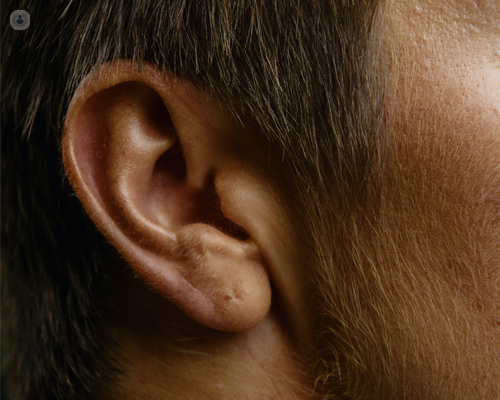Have you heard about cholesteatomas?
Written by:Cholesteatomas are a rare but potentially dangerous cyst that forms when skin cells in the ear build up. Highly experienced London-based consultant ears, nose and throat (ENT) surgeon, Mr Nish Mehta, explains the causes, risk factors, and symptoms of cholesteatomas further. He discusses the treatment and what happens if left untreated.

What is a cholesteatoma?
A cholesteatoma is a cyst that grows in the ear and is made up of skin cells. It develops deep in the ear canal and can damage the surrounding structures.
What causes it to develop?
In each patient, the cause of cholesteatoma is different and can be diagnosed from the patient’s medical history, examinations and radiological findings. For the majority of patients, a cholesteatoma is closely related to the ear drum becoming distorted. Once the ear drum is distorted, it finds it difficult to shed dying skin cells. These dying or dead skin cells stay stuck to the ear drum and continue to gather.
Are there any factors which make a person more likely to develop a cholesteatoma?
Pooling of data large studies shows those most at risk this condition tends to have had a history of ear infections, exposure to passive smoking and lower socio-economic backgrounds.
What are the symptoms of a cholesteatoma?
The most common symptom of a cholesteatoma is a discharging that either cannot be controlled with antibiotic drops or that keeps coming back. It is frequently associated with hearing loss and tinnitus.
Is it serious? What happens if it is left untreated?
It is serious as the area the cholesteatoma develops has some other important structures, all of which are at risk, from this cyst that is slowly expanding. These structures include the bones of hearing, the inner ear, the balance organ, the nerves of facial movement and taste, as well as the brain. Each of these can be irritated or damaged by the cholesteatoma.
How is a cholesteatoma treated?
The only treatment for cholesteatoma is surgery. The aim of surgery is to remove the skin cyst, reconstructing damage that the cyst has done. The surgery is done with the patient asleep with a cut behind the ear in most cases, although some can be safely done through the ear canal.
The cyst is followed in and around the ear until it can be taken out safely. We often drill around the cyst to expose all the nooks and crannies it’s hiding in. If it is surrounded the bones for hearing, these may need to be removed to reduce the chance of it coming back. Once the cyst has been cleared, all the bone that were drilled by the surgeon or dissolved by the cyst itself are reconstructed using tissue from around the ear. The hearing mechanism may need to be restored using a carefully positioned prosthesis to rebuild the ear drum. After a year a scan is taken, make sure the disease hasn’t returned.
If you are interested in booking a consultation with Mr Nish Mehta, you can do so directly via his Top Doctors profile.


